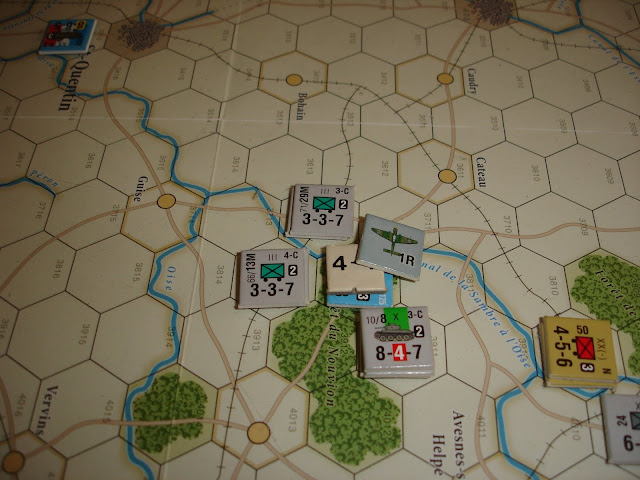But on with the campaign (I'm the Wehrmacht, Richard is the Allies). Our previous session (20 March) had resulted in three pockets by the end of Turn 4.
The pocket at Namur is ignored as it is sure to get bigger.
On the southern flank, one pocket is liquidated, while the noose around the other is strengthened.
A simple decision process as one pocket was weak and the other strong.
The strong pocket attempts to breakout, but the panzers hold firm.
In Namur the French fight through to link up with the other defenders.
Work now goes into reducing the Namur pocket.
while the panzers, lead by Rommel, push onto Charleroi.
The farthest advance on Turn 6.
8th Panzer in the lead.
Total annihilation of the southern pocket.
More French units are surrounded to the west of Namur,
but they are trying to get free.
Not going to happen.
German attacks on the Namur and Charleroi pockets.
While destructive, it ties down a number of panzer divisions that should be heading west.
This could cost the Germans victory.
In action again, 8th Panzer leads the dash westward.
Note De Gaulle in the top left hand corner of the image.
The Germans attempt to secure the southern flank,
but even at maximum odds it is hard work.
Turn 8
Are the Germans getting bogged down trying to take Namur
and clear the Charleroi corridor?
and clear the Charleroi corridor?
Their push west looks a bit thin,
but interestingly has a number of infantry divisions to the fore,
along with 8th Panzer.
along with 8th Panzer.
The 1st Panzer attacks De Gaulle at St Quentin.
The French counterattack against the German southern flank.
The big picture.
The Germans have captured the important road junctions of Cambrai and St Quentin.
More importantly their panzers are now free to move forward through Maubeuge.
The defenders of Namur are on their last legs.
At this stage the game is turning into something of a race.
















It is a long time since I played this, so my memory may be rusty, but as I recall it allows for a ‘retreat forwards’, which I think was the thing that halted play for us, as I clearly won a fight, but my opponent used his ‘retreat’ to advance to a position of advantage.
ReplyDeleteYes, you are right. When attacking I always make sure that retreat is blocked or is not going to present the enemy with an opportunity.
DeleteCertainly in this game, retreated German units have gone west. Only a few hexes and being disrupted their subsequent move is only going to be two more hexes, so that would be a max of five. A normal move would be five for infantry and nine for mech (using extended movement and road/clear terrain). It is the disruption that hurts (in this and all GMT games that use the system). Unlike the First Edition of Ukraine'43 that I am also playing, disrupted unit can't enter enemy zocs, so ability to get into a position of advantage is limited.